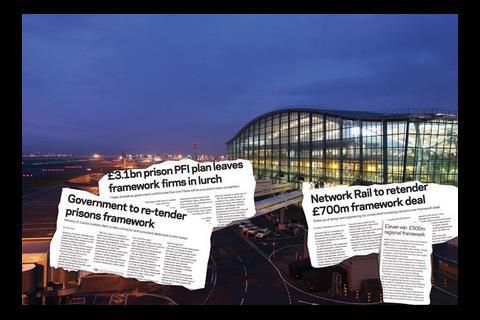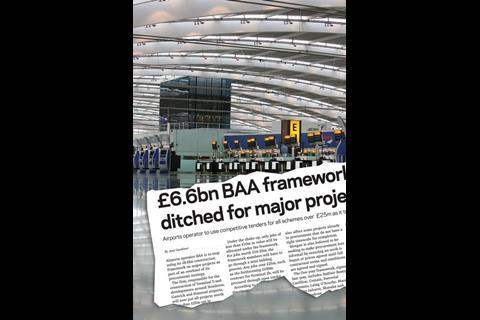During the boom, clients turned to frameworks just to get firms to do their work. In the recession, many are asking if they’re still needed
01 / Introduction
Frameworks offer access to a stream of work and an agreed pricing model. The selection process can be rigorous, but they should provide the stability that consultants and contractors need to invest in their relationships with clients and wider service development, and they were expected to provide stability in the current downturn.
However, the rules appear to have changed – future workload is no longer certain, some clients have renegotiated their pricing model, and some frameworks have so many participants that they offer little protection from price competition.
Framework arrangements have been challenged for a number of reasons including affordability and the perception that supply chains have not delivered all the framework’s performance needs. From the supply side, there is a growing sense that the benefits of membership are being diluted by lower margins, loss of volume and other changes to prequalification processes.
Prices can adjust to supply and demand quite readily as a result of the ability of the supply chain to flex its prices upwards and downwards. As a result, some recalibration in response to changed market conditions might be expected, even within a framework. The question is whether these arrangements deliver sufficient benefit to both sides to ensure they remain in place when good times return.
Frameworks are an aspect of a client’s wider procurement strategy. Once the client’s needs are identified, the procurement strategy is concerned with identifying firms with the right skills, defining what the requirements are and establishing an appropriate cost, programme and allocation of risk.
Most clients expect certainty of outcome, but few secure it – either as a result of their own scope changes or other problems. Recent innovation in the management of projects has emphasised a collaborative approach to meeting the client’s objectives, using frameworks as a means of encouraging long-term working relationships.
This model is under challenge. BAA’s shift to competitive tender is part of a move away from “client-led” project management to a model where a contractor takes full responsibility for its work – with the emphasis on value and the clear allocation of risk. Other developments such as the re-letting of the Ministry of Justice’s prison framework or repricing of frameworks by supermarkets point to a flexing of commercial muscle in a buyer’s market.
02 / Collaborative working and recession
Since the downturn started in the summer of 2008, there has been a sea change in construction procurement. On one hand, contractors’ prices, which were affecting the affordability of many projects, have been corrected; on the other, new workload is increasingly scarce, and is in some cases being bid sub-economically, with obvious implications for the post-contract management of the project.
Prior to this, there have been many positive developments: more collaborative working based on the better integration of design and construction. The management of projects has been more focused on the needs and expectations of clients, and clients and their consultants have greater access to specialist contractors. Frameworks supported by a predictable workload have enabled wider investment in client relationships and systems. Some clients have also invested in key performance indicator (KPI) systems and other forms of performance feedback to encourage continuous improvement from their team.
The case for frameworks and collaborative working was made stronger by a lack of realistic alternatives. As activity levels increased from 2006 onwards, there was not enough contractor capacity to enable clients to use all selection options. The presentation of opportunities to secure contractor interest took on a new importance as supply-chain preferences for longer-term relationships and negotiation reduced pricing pressure further in a highly inflationary market. Furthermore, contractors became progressively less able to respond to clients’ affordability and programme issues, with risk in particular being channelled in the direction of the employer through the pricing of work packages and contract conditions.
Frameworks continue to give clients in the public sector a means to fulfill the requirements of the procurement regulations. Frameworks such as that maintained by the Office of Government Commerce (OGC) mean that public sector clients do not have to run their own selection process. However, beyond the immediate requirement of compliance with the EU procurement regulations, the engagement of the supply chain with the clients’ objectives might be more limited. Under these circumstances, it is unsurprising that now that clients have more ways to choose their teams, some have opted for a greater level of price competition – particularly as prices are so low.
03 / What are clients looking for?
Any client that is able to build knows that it will secure an excellent entry price, regardless of purchasing strategy. Dealing with affordability and inflation were the client’s challenges of 2008. They are now faced with the risks associated with identifying sub-economic bids and dealing with potential problems including post-contract claims, supply-chain instability, lack of contractor initiative and so on. Securing the predicted exit price will continue to be a headache, but for very different reasons than before. In these difficult circumstances, can a framework relationship secure a better outcome? And where they exist, as in Procure 21, will the client get a return for showing loyalty and commitment to an established, pre-recession price framework?
Although single-stage competitive tendering should not inevitably result in sub-economic bids, the downturn has been so dramatic that low tenders are an increasingly likely outcome – with all that this entails for supply-chain stability and post-contract relationships. However, as many frameworks are also based on the competitive, open-book bidding of work to second-tier subcontractors, can frameworks provide the assurances that a client seeks in the current market? Affordability is an important aspect for most projects, but most clients are concerned with a wider set of issues that often revolve around people and relationships.
Key issues typically include:
- Collaborative working – collective working by the client, design team and contractor team to deliver a project that meets the client’s wider project objectives
- Sustainable supply chains – often supported by established relationships between the client, designers and specialist subcontractors, potentially managed by open-book procurement
- Evidence of value, either through benchmarking and KPIs, or through some form of price comparison
- Responsible management of the project through commitment to quality standards, the fair treatment of the supply chain and transparent pricing of risk.
Clients probably have little chance of securing these outcomes if they select their supply chain on the basis of lowest price only. However, clients with frameworks will also have to drive their teams to secure the desired outcomes, given firms are more focused on survival and the recalibration of service levels than continuous improvement. However, by continuing to build and by using frameworks or quality-based selection, clients can continue to have a positive influence in this difficult market.
04 / Types of framework
There are a bewildering range of frameworks available in the market. There are informal private sector arrangements, long-term relationships with public sector clients who control their workload, and arrangements with third-party agencies such as the Learning and Skills Council (LSC) or Building Schools for the Future, which aggregate demand from a wider group of public sector clients.
- Direct client frameworks These are the most attractive and potentially most influential frameworks because they offer a one-to-one relationship with clients that control their own workload. Here the client and suppliers have opportunities for investment in project delivery, shared systems, continuous improvement and so on. Utilities, some universities, local authorities and registered social landlords run frameworks on this basis, as do a select group of private sector clients. Some of the workload accessed through these arrangements may be procured on the basis of select competition or on the basis of target costing.
- Frameworks with an agreed commercial model Other public sector frameworks such as Procure 21 have agreed overheads and rates for management and design that will be used to establish a target price as part of a wider open-book procurement process. Under these arrangements there is not necessarily an established working relationship with the end client – consortiums still have to secure work in a quality-based competition.
- Frameworks run by intelligent procurement organisations (IPOs) These are extremely important given the scale of workload that can be accessed through them. In some cases, the end client uses “mini-competitions” to make a final appointment, based on their own terms and conditions and assumptions with regards to service level, risk transfer and so on. As a result, these frameworks do not necessarily eliminate price competition or guarantee workload. IPOs such as the OGC or the LSC aggregate work on behalf of a disparate group of clients. Others such as the IESE framework, which represents local authorities in south-east England, are based on a positive initiative to aggregate workload, build specialist teams and manage the supply chain’s performance.
As with so many aspects of life, the opportunity offered by a framework is not always clear at the outset. The key to successful relationship management is down to people and performance, and in particular in gaining an understanding from the outset as to the client’s main objectives.
In the downturn, with more consultants and contractors pursuing scarce workload, and clients having fewer resources to manage their own procurement, frameworks could increasingly be used as a means of meeting the requirements of public procurement regulations while saving on the preparation of prequalification submissions and their assessments. In these instances, the framework might offer little more than access to a second-stage, price-driven tender process. However, even that opportunity in the current market will be welcome to members, although some frameworks have so many participants that the opportunity may not be that great.
Unfortunately, the increasing complexity of the prequalification processes of IPOs mean that many frameworks favour larger organisations. It could even be argued that frameworks are having the unexpected effect of reducing the level of open competition that the OJEU regulations were designed to encourage, even though they present one of the easiest and most secure ways for clients to meet their obligations.
05 / Affordability and stability
As the industry adjusts to new conditions after 15 years of rising workload, it is vital that the framework model remain relevant to both sides and that all participants respond positively to their new commercial environment.
Competitive tendering has its place in helping to maintain financial discipline, but this is more effective within an established relationship. Sustaining frameworks through the bad times is justifiable when clients buy into the wider benefits that they secure, either through a shared approach to project delivery, or where benefits relate to the wider objectives of public clients, such as ensuring local employment.
In the current market, framework partners are best placed to support themselves and their clients by addressing the affordability and certainty through the principles of the framework. This is a huge challenge, as total savings of 20-30% of construction cost are needed to achieve viability on many projects. This can be approached using the competitive tendering route – although the implications for supply chain stability, project delivery and the exit price will be have to be addressed from the outset.
Alternatively, the challenge could be addressed collectively via a long-term relationship – facilitating the right decision making, and sharing the burden of cost reduction and performance improvement equally. Steps that could be taken via a framework to deal with the affordability challenge include:
- Reducing the size of the framework so that members have a realistic opportunity to secure enough work to support investment in the relationship. Where possible, workload should be aggregated to enable the development of specialisms over a series of projects.
- Ensuring that the coverage of a framework does not have the effect of completely denying unsuccessful bidders’ access to clients or programmes of work.
- Establishing targets for performance, cost, programme and other project deliverables at the outset of the project – clearly defining what the requirements are, and then sticking by them.
- Adopting full collaborative working between client and contractor teams in order to identify opportunities to improve value in design, specification and procurement.
- Changing weightings in supplier assessments to take into account significant reductions in pricing – so that quality and delivery assessments still count.
- Using open book pricing so that savings obtained through the general recalibration of prices, material discounts and so on in the supply chain contribute to project affordability.
- Taking steps to ensure that design solutions are fully integrated before construction through work by consultants and specialist subcontractors.
- Examining alternative models of collaborative delivery to share resources between client and delivery team, simplify project processes, increase standardisation and so on – eliminating waste as the first option before cutting margins.
- Recognising that cost reduction affects income based on either fee or overhead percentage. Introducing measures to incentivise cost reduction by consultants and contractors through the use of tapered adjustments to fees and overheads, gain share arrangements and so on.
- Providing stability to the supply chain through the involvement of the client in subcontractor selection and the elimination of re-tendering.
- Continuing investment in post-project feedback and lessons learned to facilitate continuous improvement.
Not all clients have the workload to support a framework through the current downturn, and will have to build new relationships when they re-enter the market. For those in the position to sustain working relationships, an effective framework may be the best lever available to address the value challenge that all clients face in the current market.






























No comments yet